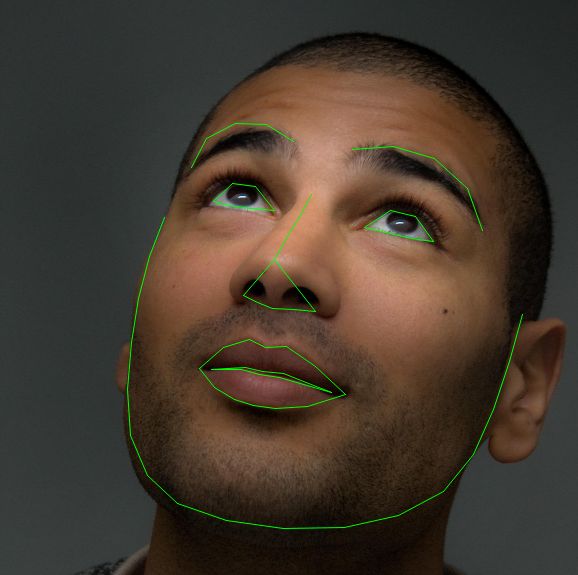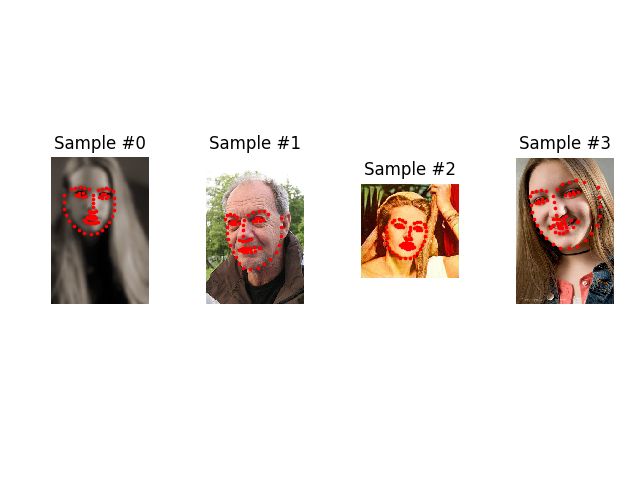PyTorch:数据加载和预处理
Github地址
简书地址
CSDN地址
此教程翻译自PyTorch官方教程
作者: Sasank Chilamkurthy
在解决任何机器学习问题上,在准备数据上会付出很大努力。PyTorch 提供了许多工具, 使数据加载变得简单,希望能使你的代码更具可读性。本教程中,我们将看到图和从一个不重要的数据集中加载和预处理/增强数据。
要运行本教程,请确保已安装一下软件包:
1. scikit-image: 用于图像 IO 和 变换
2. pandas: 更简单的 csv 解析
from __future__ import print_function, division
import os
import torch
import pandas as pd
from skimage import io, transform
import numpy as np
import matplotlib.pyplot as plt
from torch.utils.data import Dataset, DataLoader
from torchvision import transforms, utils
# Ignore warnings
import warnings
warnings.filterwarnings("ignore")
plt.ion() # interactive mode我们将要处理的数据集是面部姿势,意味着一张人脸将像下面这样被标注:

每张人脸总共有68个不同的地方被标注。
注意:
数据下载地址为 https://download.pytorch.org/tutorial/faces.zip, 图像位于名为“faces/“的目录中。这个数据集实际上是通过对来自 imagenet 的几张标注为 ‘face’ 的图片应用优秀的 dlib 的姿态估计来生成的。
数据集带有一个 csv 标注文件,里面的标注内容看起来像下面这样:
image_name,part_0_x,part_0_y,part_1_x,part_1_y,part_2_x, ... ,part_67_x,part_67_y
0805personali01.jpg,27,83,27,98, ... 84,134
1084239450_e76e00b7e7.jpg,70,236,71,257, ... ,128,312让我们快速读取 csv 文件,并把标记数据保存在一个(N, 2)的数组中,其中 N 是特征点的数量。
landmarks_frame = pd.read_csv("./data//faces/face_landmarks.csv")
n = 65
img_name = landmarks_frame.ix[n, 0]
landmarks = landmarks_frame.ix[n, 1:].as_matrix().astype('float')
landmarks = landmarks.reshape(-1, 2)
print("Image name: {}".format(img_name))
print("Landmarks shape: {}".format(landmarks.shape))
print("First 4 Landmarks: {}".format(landmarks[:4]))输出:
Image name: person-7.jpg
Landmarks shape: (68, 2)
First 4 Landmarks: [[ 32. 65.]
[ 33. 76.]
[ 34. 86.]
[ 34. 97.]]
```
让我们写一个简单的帮主函数来显示图像及其特征点,并用他来显示一个样本。
```Python
def show_landmarks(image, landmarks):
"""SHow image with landmarks"""
plt.imshow(image)
plt.scatter(landmarks[:, 0], landmarks[:, 1], s=10, marker=".", c="r")
plt.figure()
img = io.imread(os.path.join("./data/faces/", img_name))
show_landmarks(io.imread(os.path.join("./data/faces/", img_name)), landmarks)
plt.show()
```
输出:

**注意**:要得到以上结果,请把 `plt.ion()` 注释掉。
# Dataset 类
`torch.utils.data.Dataset` 是一个表示数据集的抽象类。你自定义的数据集类应该继承自 `Dataset` 并重写如下方法:
* `__len__`: 返回数据集的大小, `len(dataset)`
* `__getitem__ `: 是数据集支持索引操作, `dataset[i]`
让我们维我们的人脸特征点数据集创建一个数据集类。我们将在 `__init__` 中读取 csv, 但是让读取图片的操作在 `__getitem__` 中进行。这是内存高效的,因为所有的图像不是一次存储在内存中,而是根据需要进行读取。
我们数据集的样本将是一个字典`{'image': image, 'landmarks': landmarks}`。我们的数据集将接受一个可选参数`transform’ 以便可以对样本应用任何需要的处理。我们将在下一节看到 `transform` 的好处。
```Python
class FaceLandmarksDataset(Dataset):
"""Face Landmarks dataset."""
def __init__(self, csv_file, root_dir, transform=None):
"""
Args:
csv_file (string): Path to the csv file with annotations.
root_dir (string): Directory with all the images.
transform (callable, optional): Optional transform to be applied
on a sample.
"""
self.landmarks_frame = pd.read_csv(csv_file)
self.root_dir = root_dir
self.transform = transform
def __len__(self):
return len(self.landmarks_frame)
def __getitem__(self, idx):
img_name = os.path.join(self.root_dir, self.landmarks_frame.ix[idx, 0])
image = io.imread(img_name)
landmarks = self.landmarks_frame.ix[idx, 1:].as_matrix().astype('float')
landmarks = landmarks.reshape(-1, 2)
sample = {'image': image, 'landmarks': landmarks}
if self.transform:
sample = self.transform(sample)
return sample
class="se-preview-section-delimiter">div>
让我们初始化这个类的实例,并在数据样本上迭代。我们讲打印开始4个样本的大小并显示他们的特征点。
face_dataset = FaceLandmarksDataset(csv_file='faces/face_landmarks.csv',
root_dir='faces/')
fig = plt.figure()
for i in range(len(face_dataset)):
sample = face_dataset[i]
print(i, sample['image'].shape, sample['landmarks'].shape)
ax = plt.subplot(1, 4, i + 1)
plt.tight_layout()
ax.set_title('Sample #{}'.format(i))
ax.axis('off')
show_landmarks(**sample)
if i == 3:
plt.show()
break
<div class="se-preview-section-delimiter">div>
输出:
0 (324, 215, 3) (68, 2)
1 (500, 333, 3) (68, 2)
2 (250, 258, 3) (68, 2)
3 (434, 290, 3) (68, 2)
<div class="se-preview-section-delimiter">div>
Transform (变换)
从上面的例子我们可以看到一个问题:样本的尺寸不一样。大部分的神经网络希望一个固定大小的图像。因此,我们需要写一些预处理代码。让我们来创建三种变换:
Rescale: 缩放图像RandomCrop: 随机剪裁图像,这是一种数据增强的方法ToTensor: 把 numpy 图像转换为 PyTorch 图像(我们需要交换轴)
我们将把它们写成一个可调用的类而不是函数,所以变换所需的参数不必在每次调用时都传递。为此,我们只需实现 __call__ 方法,如果需要可以实现 __init__ 方法。我们可以向下面这样使用他们:
tsfm = Transform(params)
transformed_sample = tsfm(sample)
<div class="se-preview-section-delimiter">div>
请观察下面的变换是如何应用在图像和特征点上的。
class Rescale(object):
"""Rescale the image in a sample to a given size.
Args:
output_size (tuple or int): Desired output size. If tuple, output is
matched to output_size. If int, smaller of image edges is matched
to output_size keeping aspect ratio the same.
"""
def __init__(self, output_size):
assert isinstance(output_size, (int, tuple))
self.output_size = output_size
def __call__(self, sample):
image, landmarks = sample['image'], sample['landmarks']
h, w = image.shape[:2]
if isinstance(self.output_size, int):
if h > w:
new_h, new_w = self.output_size * h / w, self.output_size
else:
new_h, new_w = self.output_size, self.output_size * w / h
else:
new_h, new_w = self.output_size
new_h, new_w = int(new_h), int(new_w)
img = transform.resize(image, (new_h, new_w))
# h and w are swapped for landmarks because for images,
# x and y axes are axis 1 and 0 respectively
landmarks = landmarks * [new_w / w, new_h / h]
return {'image': img, 'landmarks': landmarks}
class RandomCrop(object):
"""Crop randomly the image in a sample.
Args:
output_size (tuple or int): Desired output size. If int, square crop
is made.
"""
def __init__(self, output_size):
assert isinstance(output_size, (int, tuple))
if isinstance(output_size, int):
self.output_size = (output_size, output_size)
else:
assert len(output_size) == 2
self.output_size = output_size
def __call__(self, sample):
image, landmarks = sample['image'], sample['landmarks']
h, w = image.shape[:2]
new_h, new_w = self.output_size
top = np.random.randint(0, h - new_h)
left = np.random.randint(0, w - new_w)
image = image[top: top + new_h,
left: left + new_w]
landmarks = landmarks - [left, top]
return {'image': image, 'landmarks': landmarks}
class ToTensor(object):
"""Convert ndarrays in sample to Tensors."""
def __call__(self, sample):
image, landmarks = sample['image'], sample['landmarks']
# swap color axis because
# numpy image: H x W x C
# torch image: C X H X W
image = image.transpose((2, 0, 1))
return {'image': torch.from_numpy(image),
'landmarks': torch.from_numpy(landmarks)}
class="se-preview-section-delimiter">
组合变换
现在,我们应用这些变换到我们的样本上。
假如我们想先把图像的较短的一边缩放到256,然后从中随机剪裁一个224*224大小的图像。即我们想要组合 Rescale 和 RandomCrop 两个变换。
torchvision.transforms.Compose 是一个简单的可调用类,允许我们来组合多个变换
scale = Rescale(256)
crop = RandomCrop(128)
composed = transforms.Compose([Rescale(256),
RandomCrop(224)])
"se-preview-section-delimiter">
# Apply each of the above transforms on sample.
fig = plt.figure()
sample = face_dataset[65]
for i, tsfrm in enumerate([scale, crop, composed]):
transformed_sample = tsfrm(sample)
ax = plt.subplot(1, 3, i + 1)
plt.tight_layout()
ax.set_title(type(tsfrm).__name__)
show_landmarks(**transformed_sample)
plt.show()
"se-preview-section-delimiter">
[站外图片上传中…(image-c83c50-1523363049459)]
迭代数据集
我们把这些放在一个来创建一个包含组合变换的数据集。总之,每当这个数据集被采样时执行一下操作:
* 即时从文件中读取图像。
* 对图像应用变换。
* 由于其中一个变换是随机的,因此数据的采样得到增强。
我们可以使用和之前一样的 for i in range 循环来迭代创建的数据集。
transformed_dataset = FaceLandmarksDataset(csv_file='faces/face_landmarks.csv',
root_dir='faces/',
transform=transforms.Compose([
Rescale(256),
RandomCrop(224),
ToTensor()
]))
for i in range(len(transformed_dataset)):
sample = transformed_dataset[i]
print(i, sample['image'].size(), sample['landmarks'].size())
if i == 3:
break
<div class="se-preview-section-delimiter">div>
输出:
0 torch.Size([3, 224, 224]) torch.Size([68, 2])
1 torch.Size([3, 224, 224]) torch.Size([68, 2])
2 torch.Size([3, 224, 224]) torch.Size([68, 2])
3 torch.Size([3, 224, 224]) torch.Size([68, 2])
"se-preview-section-delimiter">
但是,通过使用简单的for循环遍历数据,我们将失去许多功能。特别是我们错过了:
* 批处理数据
* 打乱数据
* 使用多线程并行加载数据
torch.utils.data.DataLoader 是一个提供以上所有的功能的迭代器。下面使用的参数应该是清楚的。其中一个又去的参数是 collate_fn。你可以指定如何使用 collate_fn 对样本进行批处理。但是,对大多数情况来说,默认的自动分页应该可以正常工作的很好。
dataloader = DataLoader(transformed_dataset, batch_size=4,
shuffle=True, num_workers=4)
class="se-preview-section-delimiter">
# Helper function to show a batch
def show_landmarks_batch(sample_batched):
"""Show image with landmarks for a batch of samples."""
images_batch, landmarks_batch = \
sample_batched['image'], sample_batched['landmarks']
batch_size = len(images_batch)
im_size = images_batch.size(2)
grid = utils.make_grid(images_batch)
plt.imshow(grid.numpy().transpose((1, 2, 0)))
for i in range(batch_size):
plt.scatter(landmarks_batch[i, :, 0].numpy() + i * im_size,
landmarks_batch[i, :, 1].numpy(),
s=10, marker='.', c='r')
plt.title('Batch from dataloader')
for i_batch, sample_batched in enumerate(dataloader):
print(i_batch, sample_batched['image'].size(),
sample_batched['landmarks'].size())
# observe 4th batch and stop.
if i_batch == 3:
plt.figure()
show_landmarks_batch(sample_batched)
plt.axis('off')
plt.ioff()
plt.show()
break
class="se-preview-section-delimiter">
输出:
“`
0 torch.Size([4, 3, 224, 224]) torch.Size([4, 68, 2])
1 torch.Size([4, 3, 224, 224]) torch.Size([4, 68, 2])
2 torch.Size([4, 3, 224, 224]) torch.Size([4, 68, 2])
3 torch.Size([4, 3, 224, 224]) torch.Size([4, 68, 2])

